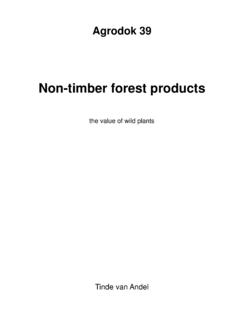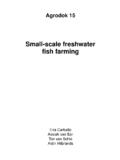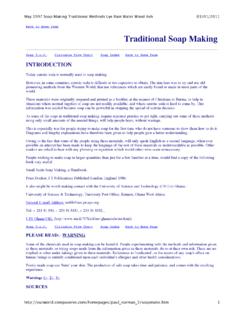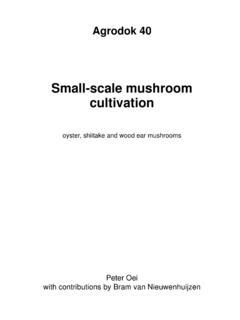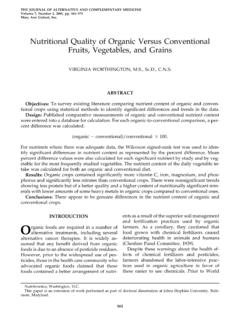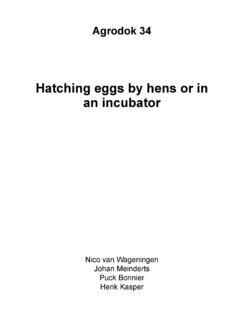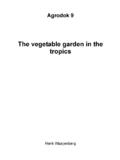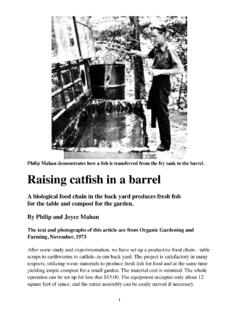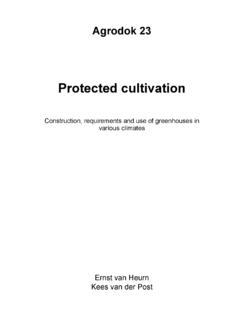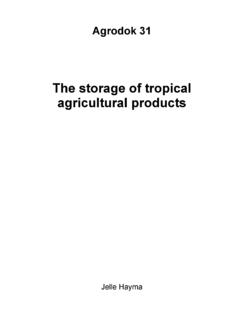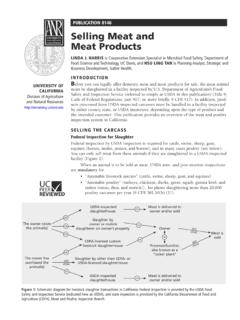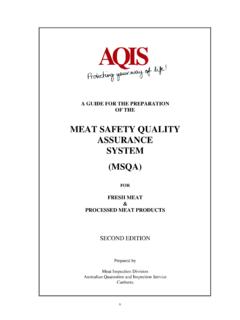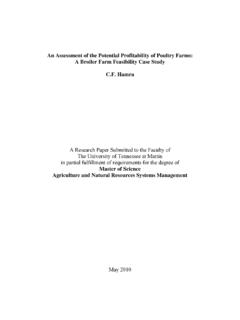Transcription of 12-e-revisie 20-11-04 edited - Journey to Forever
1 Agrodok 12 Preservation of fish and meat Brigitte Maas-van Berkel Brigiet van den Boogaard Corlien Heijnen Agromisa Foundation, Wageningen, 2004. All rights reserved. No part of this book may be reproduced in any form, by print, photocopy, microfilm or any other means, without written permission from the publisher. First English edition: 1994 Second edition: 2002 Third revised edition: 2004 Authors: Brigitte Maas-van Berkel, Brigiet van den Boogaard, Corlien Heijnen Editor: Marja de Goffau-Markusse Translation: Joost Guijt, Catharina de Kat-Reynen (editing) Printed by: Digigrafi, Wageningen, the Netherlands ISBN: 90-72746-01-9 NUGI: 835 Foreword 3 ForewordThis Agrodok is intended as a practical manual that reviews the simple techniques used to preserve fish and meat.
2 The booklet gives guide-lines for several preservation techniques. The methods described and the results achieved can, of course, differ locally. The general introduction deals with the principles of preventing spoil-age. Next, the various methods of preserving foods are explained and the main aspects of spoilage relevant to each method are covered. Special attention is given to the question of which method to choose given the local conditions. The following topics are discussed: salting, drying and smoking of fish and meat; fermentation of fish; canning of fish and meat; and cooling and freezing fish and meat. The authors have endeavoured to describe each method as practically as possible, including descriptions of the required materials and tech-niques.
3 In this revised edition some descriptions of techniques were modified, illustrations were added and lists of sources for further information were updated. I would like to thank Jacques Houben and Ife Fitz James for their valuable observations after critically reading this docu-ment and Barbera Oranje for making some new illustrations. Marja de Goffau-Markusse Wageningen, 2004 Preservation of fish and meat 4 Contents1 Introduction 6 2 Storage life and spoilage of fish and meat 8 How long can fish or meat be kept? 8 When has fish or meat gone bad? 8 Which micro-organisms spoil fish and meat? 10 Spoilage and/or fish and meat poisoning 10 How does contamination take place?
4 12 How does one prevent contamination? Hygiene! 12 Prevention of spoilage 13 Which method should be chosen? 15 3 Preparation of fish and meat 16 Catching and cleaning fish 16 Butchering 21 Cutting meat into pieces for drying 22 4 Salting fish and meat 25 General information 25 Salting fish 26 Salting meat 32 Preparing salted fish and meat for consumption 36 5 Drying fish and meat 37 General information on natural drying 37 Preparation 38 Hanging fish and meat up to dry 38 The drying process 40 Dried fish and meat: storage and use 41 Solar drying 43 6 Smoking fish and meat 46 General information 46 Contents Preparation 47 Wood 48 Smoking ovens 48 Smoke-drying process 52 Remarks 53 7 Fermenting fish 54 General information 54 Fermentation 54 Traditional fermentation methods 55 Fermented fish sauce with 20-25% salt 57 Fish pastes
5 And whole fish 59 Remarks 63 8 Canning fish and meat 64 General information 64 Advantages and disadvantages of the canning process 65 Packaging materials 66 processing equipment 68 Preparation 69 processing techniques 71 Storage 76 Setting up a small-scale canning factory: prerequisites 76 9 Cooling and freezing fish and meat 78 General information 78 Cooling and freezing fish 79 Cooling and freezing meat 80 Further reading 82 Useful addresses 84 Glossary 86 Preservation of fish and meat 6 1 IntroductionPreservation is the processing of foods so that they can be stored longer.
6 Man is dependent on products of plant and animal origin for food. Because most of these products are readily available only during certain seasons of the year and because fresh food spoils quickly, methods have been developed to preserve foods. Preserved foods can be eaten long after the fresh products would normally have spoiled. With the growth of towns, the need to preserve foods longer increased as some people could no longer grow their own vegetables nor keep animals. Preservation must be seen as a way of storing excess foods that are abundantly available at certain times of the year, so that they can be consumed in times when food is scarce. Consumption of fresh foods is always preferable, however, as preservation usually decreases the nu-tritional value.
7 In other words, preserved foods are not as healthy as fresh foods. A number of simple preservation techniques suitable for small-scale preservation, such as at the household or village level, will be de-scribed in this booklet. The emphasis is on small-scale , to inform individuals how to process and store their surplus economically. In times of scarcity, preserved foods can be a welcome addition to the diet. Through preservation, sales of out of season products are possi-ble and prices asked are independent of the usually lower market prices during the harvest season. This booklet starts with a discussion of spoilage and its prevention. Knowledge of the causes of spoilage is necessary in order to be able to preserve foods correctly.
8 After that, the principles and the methods of preservation are explained and the advantages and disadvantages of each method are described. Introduction 7 The following preservation methods are discussed: salting, drying and smoking of fish and meat, fermenting of fish, canning of fish and meat, and cooling and freezing of fish and meat. Preservation of fish and meat 8 2 Storage life and spoilage How long can fish or meat be kept? Fresh fish will spoil very quickly. Once the fish has been caught, spoilage progresses rapidly. In the high ambient temperatures of the tropics, fish will spoil within 12 hours.
9 Using good fishing techniques (to ensure the fish is barely damaged) and cooling the fish, with the help on ice on board, can increase the storage life of fresh fish. The speed with which meat spoils not only depends on hygiene condi-tions and storage temperature, but also on the acidity of the meat and the structure of the muscular tissue. The firm muscular tissue of beef, for example, spoils less quickly than liver. Hygienic slaughtering and clean handling of the carcass have a positive effect on storage life. Af-ter slaughtering, one should preserve the meat as quickly as possible. When has fish or meat gone bad? Spoilage is the deterioration of food which makes it taste and smell bad ( when it is sour, rotten or mouldy) and/or makes it a carrier of disease germs.
10 Properties of spoiled fish compared to fresh fish are: ? strong odour ? dark-red gills with slime on them instead of bright red ones ? soft flesh with brown traces of blood instead of firm flesh with red blood ? red, milky pupils without slime instead of clear ones The onset of spoilage in meat is seen by changes in colour, among other things. Typical spoilage smells also develop (such as a rotten egg smell). Storage life and spoilage 9 Spoiled food, when consumed, can cause symptoms such as diarrhoea, stomach pains, nausea and vomiting, and stomach infections or cramps. In very serious cases it can cause death. In fish and meat the most important kinds of spoilage are: 1 microbiological spoilage caused by bacteria 2 autolytic spoilage caused by enzymes 3 fat oxidation 1 Bacteria are single-celled micro-organisms that are invisible to the naked eye.
